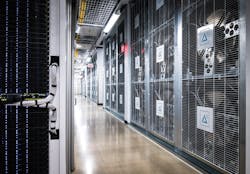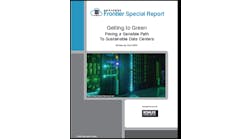In this week’s edition of Voices of the Industry, Andrew Schaap, CEO at Aligned Energy, explores how cloud service providers and enterprises alike can mitigate the risk of capacity constraints today and into the future.
Andrew Schaap, CEO, Aligned Energy
Gordon Moore is not the only one who should take the blame for making capacity planning arguably the hardest job in the data center. There’s also Buckminster Fuller: in 1982, he posited the Knowledge Doubling Curve (which looks strikingly similar to Moore’s Law). Think of “human knowledge” as a book containing everything we know – how often does the book double in length? In 1900, human knowledge doubled every century. By the mid-1900s, it was doubling every 25 years. Today, human knowledge doubles every 13 months.
This accelerated pace of human knowledge development goes hand-in-hand with the accelerating pace of computing power. And both are equally responsible for making the job of capacity planning increasingly difficult. The only thing predictable about technological change is that it will continue to accelerate.
The capacity planning challenge
The burden of such rapid technological advancement falls on the physical infrastructure – the data centers that make up the factory of the digital age. Very rapid technological change means that future demand for data center capacity is anybody’s guess. And that makes life challenging for even the most sophisticated capacity planners.
A large part of the challenge stems from the fact that technology advances much more rapidly than the physical infrastructure supporting it. A server is a two-or three-zero capital expense with a lifecycle of 3-5 years. A data center is a six-, seven-, or eight-zero capital expense with a lease term or depreciation schedule of 15-30 years. Neither the data center’s physical plant nor its consumption models are designed to be very flexible.
[clickToTweet tweet=”Andrew Schaap – The only thing predictable about technological change is that it will continue to accelerate.” quote=”Andrew Schaap – The only thing predictable about technological change is that it will continue to accelerate.”]
Solving the challenge
If a data center deployment could be “refreshed” every 3-5 years and procured as quickly and easily as a rack of IT gear, then alignment would be easy. But the data center is a much longer and more expensive commitment. So it needs to be what Aligned Energy founder and CTO Jakob Carnemark referred to as “adaptive.”
You could call an adaptive data center future-proof. It is a data center able to match the changing needs of its clients – a data center that can quickly and efficiently deliver new capacity and quickly and efficiently add capacity to existing deployments. (Efficiently is an operative word – meaning, without stranding capacity or requiring footprint reconfigurations or cooling add-ons.)
Delivering net new capacity quickly
Overcoming the challenge of delivering capacity quickly is all about mitigating risk – mitigating the risk of not being able to meet the needs of the business. “Delivering new capacity fast” means delivering multi-megawatts of provisioned capacity in less than 12 weeks. We do that by combining highly scalable, factory-built components with pre-provisioned capacity on site.
Bringing capacity online quickly requires a reliable data center partner that will deliver. That is a data center partner who is easy to work with – from initial discussions about requirements all the way through to day-to-day operations. At Aligned Energy, our experienced teams are solution-oriented and geared towards speed-to-delivery.
Scaling up and out
Responding to changing needs also means quickly and efficiently adding capacity to existing deployments. That requires the ability to scale up (increase power density) and out (increase the footprint) without stranding capacity. Our factory-built, incrementally scalable infrastructure allows clients to increase capacity vertically and horizontally as needed, when needed, without operational disruption.
Scaling up means increasing density in the existing footprint – and it should be possible to do without stranding capacity, reconfiguring the data center footprint, or adding on cooling technologies. Our cooling technology is adaptable to clients’ IT requirements – supporting standard and high power densities (1-50kW per rack) without add-ons or reconfigurations.
Stress-less capacity planning
Having a data center that can deliver capacity fast, scale up, and scale out takes the stress out of data center capacity planning. When a data center is designed to scale up and out, then future-proofing doesn’t require overprovisioning capacity to mitigate risk.
As I wrote in my first blog post as CEO of Aligned Energy, “Organizations are only as agile, fast, and visionary as their data centers. Cloud, colocation, or on-premises, the data center is the factory of the digital age. Success requires a data center partner who can deliver compute, storage, and network capacity nimbly and quickly and has a strategic vision for how to meet the capacity needs of tomorrow.”
That’s how you prepare for a future no one can imagine.
Andrew Schaap is CEO of Aligned Energy, an infrastructure technology company that offers colocation and build-to-scale solutions to cloud, enterprise, and service providers.






